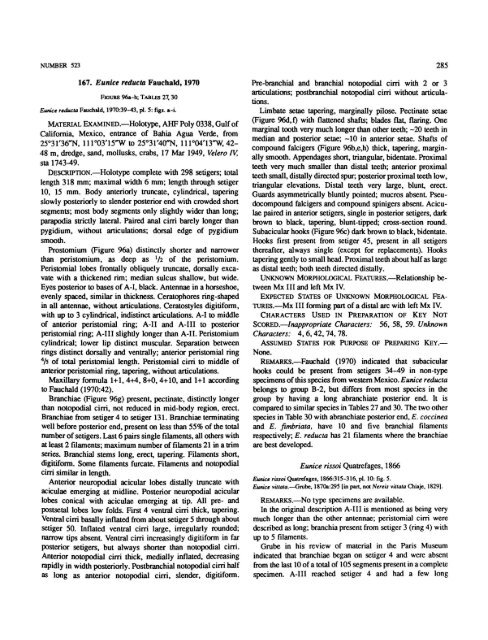A Review of the Genus Eunice - Smithsonian Institution Libraries
A Review of the Genus Eunice - Smithsonian Institution Libraries
A Review of the Genus Eunice - Smithsonian Institution Libraries
You also want an ePaper? Increase the reach of your titles
YUMPU automatically turns print PDFs into web optimized ePapers that Google loves.
NUMBER 523 285<br />
167. <strong>Eunice</strong> reducta Fauchald, 1970<br />
FIOURE 96a-h; TABLES 27, 30<br />
<strong>Eunice</strong> reducta Fauchald. 1970:39-43, pi. 5: figj. a-i.<br />
MATERIAL EXAMINED.—Holotype, AHF Poly 0338, Gulf <strong>of</strong><br />
California, Mexico, entrance <strong>of</strong> Bahia Agua Verde, from<br />
25°31'36"N, lll°03'15"W to 25°31'40"N, lll o 04'13"W, 42-<br />
48 m, dredge, sand, mollusks, crabs, 17 Mar 1949, Velero IV,<br />
sta 1743-49.<br />
DESCRIPTION.—Holotype complete with 298 setigers; total<br />
length 318 mm; maximal width 6 mm; length through setiger<br />
10, 15 mm. Body anteriorly truncate, cylindrical, tapering<br />
slowly posteriorly to slender posterior end with crowded short<br />
segments; most body segments only slightly wider than long;<br />
parapodia strictly lateral. Paired anal cirri barely longer than<br />
pygidium, without articulations; dorsal edge <strong>of</strong> pygidium<br />
smooth.<br />
Prostomium (Figure 96a) distinctly shorter and narrower<br />
than peristomium, as deep as<br />
x li <strong>of</strong> <strong>the</strong> peristomium.<br />
Peristomial lobes frontally obliquely truncate, dorsally excavate<br />
with a thickened rim; median sulcus shallow, but wide.<br />
Eyes posterior to bases <strong>of</strong> A-I, black. Antennae in a horseshoe,<br />
evenly spaced, similar in thickness. Ceratophores ring-shaped<br />
in all antennae, without articulations. Ceratostyles digitiform,<br />
with up to 3 cylindrical, indistinct articulations. A-I to middle<br />
<strong>of</strong> anterior peristomial ring; A-I I and A-I II to posterior<br />
peristomial ring; A-I 11 slightly longer than A-I I. Peristomium<br />
cylindrical; lower lip distinct muscular. Separation between<br />
rings distinct dorsally and ventrally; anterior peristomial ring<br />
4 /5 <strong>of</strong> total peristomial length. Peristomial cirri to middle <strong>of</strong><br />
anterior peristomial ring, tapering, without articulations.<br />
Maxillary formula 1+1, 444, 8+0, 4+10, and 1+1 according<br />
to Fauchald (1970:42).<br />
Branchiae (Figure 96g) present, pectinate, distinctly longer<br />
than notopodial cirri, not reduced in mid-body region, erect.<br />
Branchiae from setiger 4 to setiger 131. Branchiae terminating<br />
well before posterior end, present on less than 55% <strong>of</strong> <strong>the</strong> total<br />
number <strong>of</strong> setigers. Last 6 pairs single filaments, all o<strong>the</strong>rs with<br />
at least 2 filaments; maximum number <strong>of</strong> filaments 21 in a trim<br />
series. Branchial stems long, erect, tapering. Filaments short,<br />
digitiform. Some filaments furcate. Filaments and notopodial<br />
cirri similar in length.<br />
Anterior neuropodial acicular lobes distally truncate with<br />
aciculae emerging at midline. Posterior neuropodial acicular<br />
lobes conical with aciculae emerging at tip. All pre- and<br />
postsetal lobes low folds. First 4 ventral cirri thick, tapering.<br />
Ventral cirri basally inflated from about setiger 5 through about<br />
setiger 50. Inflated ventral cirri large, irregularly rounded;<br />
narrow tips absent. Ventral cirri increasingly digitiform in far<br />
posterior setigers, but always shorter than notopodial cirri.<br />
Anterior notopodial cirri thick, medially inflated, decreasing<br />
rapidly in width posteriorly. Postbranchial notopodial cirri half<br />
as long as anterior notopodial cirri, slender, digitiform.<br />
Pre-branchial and branchial notopodial cirri with 2 or 3<br />
articulations; postbranchial notopodial cirri without articulations.<br />
Limbate setae tapering, marginally pilose. Pectinate setae<br />
(Figure 96d,f) with flattened shafts; blades flat, flaring. One<br />
marginal tooth very much longer than o<strong>the</strong>r teeth; -20 teeth in<br />
median and posterior setae; -10 in anterior setae. Shafts <strong>of</strong><br />
compound falcigers (Figure 96b,e,h) thick, tapering, marginally<br />
smooth. Appendages short, triangular, bidentate. Proximal<br />
teeth very much smaller than distal teeth; anterior proximal<br />
teeth small, distally directed spur, posterior proximal teeth low,<br />
triangular elevations. Distal teeth very large, blunt, erect.<br />
Guards asymmetrically bluntly pointed; mucros absent. Pseudocompound<br />
falcigers and compound spinigers absent. Aciculae<br />
paired in anterior setigers, single in posterior setigers, dark<br />
brown to black, tapering, blunt-tipped; cross-section round.<br />
Subacicular hooks (Figure 96c) dark brown to black, bidentate.<br />
Hooks first present from setiger 45, present in all setigers<br />
<strong>the</strong>reafter, always single (except for replacements). Hooks<br />
tapering gently to small head. Proximal teeth about half as large<br />
as distal teeth; both teeth directed distally.<br />
UNKNOWN MORPHOLOGICAL FEATURES.—Relationship between<br />
Mx III and left Mx IV.<br />
EXPECTED STATES OF UNKNOWN MORPHOLOGICAL FEA-<br />
TURES.—Mx III forming part <strong>of</strong> a distal arc with left Mx IV.<br />
CHARACTERS USED IN PREPARATION OF KEY NOT<br />
SCORED.—Inappropriate Characters: 56, 58, 59. Unknown<br />
Characters: 4,6,42, 74,78.<br />
ASSUMED STATES FOR PURPOSE OF PREPARING KEY.—<br />
None.<br />
REMARKS.—Fauchald (1970) indicated that subacicular<br />
hooks could be present from setigers 34-49 in non-type<br />
specimens <strong>of</strong> this species from western Mexico. <strong>Eunice</strong> reducta<br />
belongs to group B-2, but differs from most species in <strong>the</strong><br />
group by having a long abranchiate posterior end. It is<br />
compared to similar species in Tables 27 and 30. The two o<strong>the</strong>r<br />
species in Table 30 with abranchiate posterior end, E. coccinea<br />
and E. fimbriata, have 10 and five branchial filaments<br />
respectively; E. reducta has 21 filaments where <strong>the</strong> branchiae<br />
are best developed.<br />
<strong>Eunice</strong> rissoi Quatrefages, 1866<br />
<strong>Eunice</strong> rissoi Quatrefages, 1866:315-316, pi. 10: fig.5.<br />
<strong>Eunice</strong> vittata.—Gmbc, 1870a:295 [in part, not Nereis vittata Chiaje, 1829].<br />
REMARKS.—No type specimens are available.<br />
In <strong>the</strong> original description A-I 11 is mentioned as being very<br />
much longer than <strong>the</strong> o<strong>the</strong>r antennae; peristomial cirri were<br />
described as long; branchia present from setiger 3 (ring 4) with<br />
up to 5 filaments.<br />
Grube in his review <strong>of</strong> material in <strong>the</strong> Paris Museum<br />
indicated that branchiae began on setiger 4 and were absent<br />
from <strong>the</strong> last 10 <strong>of</strong> a total <strong>of</strong> 105 segments present in a complete<br />
specimen. A-I 11 reached setiger 4 and had a few long
















